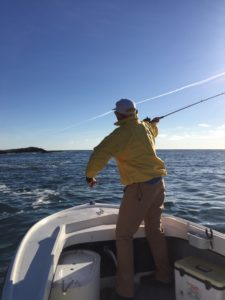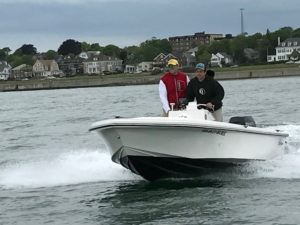By DAVID LISCIO
When Bob Dobias Jr. was just out of high school, he convinced his mother, Sharon, to drive from their Swampscott home to Maine and buy a weather-beaten Mako skiff. It was a strategic move, because his father, Bob Sr., was busy coaching Swampscott High School’s football team, so there was little chance of encountering resistance.
The purchase set in motion what became an unbridled passion for boats – whether barreling across the waters of Massachusetts Bay, fishing for stripers and bluefish or, more recently, building hulls from molds in his own shop.
Determined to refurbish the fiberglass Mako skiff, Bob Jr. rented a work tent at Redd’s Pond in Marblehead. “It was really cold in winter, but the price was right,” he said. “That was about ten years ago and I think we paid $100 a month in rent.”
A self-taught craftsman, Bob Jr. gutted the skiff, rebuilt it, then bought a battered 13-foot Boston Whaler and started over.
“It was on to the next project,” said younger brother Dorsey.

Fly fishing from a Cape Codder boat.
These days, Bob Jr., 31, and Dorsey, 27, both Swampscott High graduates who went on to earn their bachelor’s degrees, work alongside their father at Cape Codder Boats, which has relocated its shop from an industrial warehouse in Peabody to a small shop at 59 Newhall St. in Lynn.
The company builds 24-foot and 19-foot fiberglass fishing boats that are most often completed with a center console and powered by an outboard engine. Cape Codder Boats also produces two small skiffs preferred by commercial fishermen and recreational anglers alike – a 14-footer and a 10-footer.
The two Bobs handle the boat construction while Dorsey Dobias, a financial analyst at a North Shore bank, takes care of budgeting, planning, marketing and advertising. Most of the boats are built during winter because in warmer weather Bob Sr. and Bob Jr. are full-time lobstermen fishing out of Swampscott Harbor aboard their 28-foot boat the Sharon Lee.
Father and son began commercial fishing four years ago and are planning to buy a larger vessel – unless, of course, their boat-building company continues its steady growth and consumes their time year round.
“Those two spend a lot of time together,” quipped Dorsey, noting his older brother occasionally heads for the boat shop after the day’s lobster catch has been banded, sorted and sold to a vendor in Marblehead. “There’s no stopping them.”
“We’re getting busier all the time,” said Bob Jr., who in mid-September completed work on a Cape Codder 19 that will serve as one of two grand prizes at the 72nd annual Martha’s Vineyard Striped Bass & Bluefish Derby in Edgartown. Cape Codder Boats is a major derby sponsor in partnership with Tohatsu marine engines. Tohatsu is providing a 90-horsepower outboard to complete the package, which includes a trailer.
The tournament lasts 35 days, after which the winners are ceremoniously announced. The fisherman who lands the biggest catch from shore gets the Cape Codder 19, while the angler who hauls in the prize fish from a boat gets a Subaru Crosstrek from sponsor Clay Subaru. About 3,500 fishermen enter the derby each year.
“Not bad prizes for the $50 entry fee,” observed Dorsey.

Dorsey and Bob Dobias Jr. try out a
Speedster in the waters off Lynn Shore Drive.
Cape Codder Boats is located today in a shared industrial building just off the Lynnway that includes a small equipment yard. During a September visit to the shop by One magazine, a freshly-fiberglassed hull awaited interior work – which typically means adding longitudinal stringers for stability, filling the lower spaces with floatation foam, constructing a sole or floor, and trimming the entire vessel with a coaming and rod holders.
The Dobias family trailered a similar Cape Codder 19 in mid-September to Edgartown and parked it outside the derby headquarters where the weigh station is located and the grand prizes are on display.
Cape Codder Boats was founded in 1968 by Alex “Sandy” Urquhart in Marion. His 19-foot skiff attracted a strong following among anglers, as the boats received best-in-class awards and were often described in the marine industry press as rugged and over-built. Urquhart eventually moved the shop to Chatham.
Now retired, Urquhart recalled how he wanted to design a small boat that incorporated all the elements of the most seaworthy boats at the time. For instance, the hull featured an 18-degree deadrise, which in landlubber terms means the angle of the hull from its deepest point to where it meets the side of the boat.
“That 18-degree angle provides a more stable platform,” Urquhart explained. “The sharper the hull, the more tippy the boat. Sharp angles are great for high speeds, but not for when you’re stopping to fish.”
Urquhart also relied on lifting strakes, which are raised strips linearly attached to the bottom of the hull. The strips allow the boat to rise out of the water as it moves forward. According to Urquhart, nautical architect Raymond Hunt is credited with designing the lifting strakes years earlier.
A self-taught boat builder, Urquhart went on to design a 24-footer for those who demanded a more stable platform while fishing, lobstering or scalloping inshore, or venturing out into deeper water. He retired from building boats in the late 1980s after launching more than 200 hulls, mostly on the South Shore where Cape Codder Boats is a household name. “Most of them are still out there,” he said. “They might need some TLC, but the guys are still fishing them.”
Bob Jr. spent time with Urquhart to learn as much as possible about the two boats and how to build them. He also acquired the mold for the 19-footer.
“Seven or eight years ago, we came across the mold for the Cape Codder 19,” Bob Jr. recalled. “We moved out of Redd’s Pond and got an indoor space at an old industrial building on Pulaski Street in Peabody. We spent a couple of years there building boats part time.”
Building a boat from fiberglass could be compared to greasing a cupcake pan before baking. The mold, often made of smooth wood, is sanded, waxed and polished on the inside, then sprayed with an alcohol film that creates a barrier coating. The fiberglass resin and matting is then applied and, once dried, is literally popped out of the mold.
“When the hull is finished, you put in the transom, the floor and the deck,” Urquhart said. “I used to sell mine with options. If somebody wanted to put a davit on to haul lobster traps, I would beef up the floor to give them something to bolt it to.”
The Dobias family has followed suit, offering custom finishes tailored to the intended use.
“The boats have lots of open work area. That’s what most of the guys like about them,” said Bob Sr., who admits he had no boating experience, except for paddling a canoe, when the family decided to build boats.
Raised in western Massachusetts, Bob Sr. spent many years working for a printing company in upstate New York and Texas, where he met the co-worker who would become his wife. He also made maple syrup and, after moving to Swampscott, coached the high school football team from 2002 to 2016 while also overseeing the town’s youth sports program and serving on the School Board.
“I didn’t have much contact with boats,” he said. “We never had a boat in the family until we moved here and my son brought home that Mako.”
Bob Jr., a certified arborist who worked locally for Leahy Landscaping after graduating from UMass Dartmouth, wanted to build smaller skiffs like those often used as tenders by commercial fishermen. Always on the lookout for boats, he acquired a 14-footer from Nahant lobsterman Joel Marie. He used the old skiff as a plug from which to make a mold. “It was just great to make a shape from,” he said, noting he quickly churned out seven of the tenders and sold them to Nahant commercial fishermen.
“It’s true that commercial fishermen love our boats, but recreational guys like them as well because they’re so stable,” said Dorsey, who acquired his financial savvy at the University of the South in Sewanee, Tenn. “Our boat at the Martha’s Vineyard derby is set up for fly fishing. Now that’s a totally different market. We also do rebuilds.”
David Liscio is a North Shore-based photojournalist. He can be reached at davidliscio.com.






